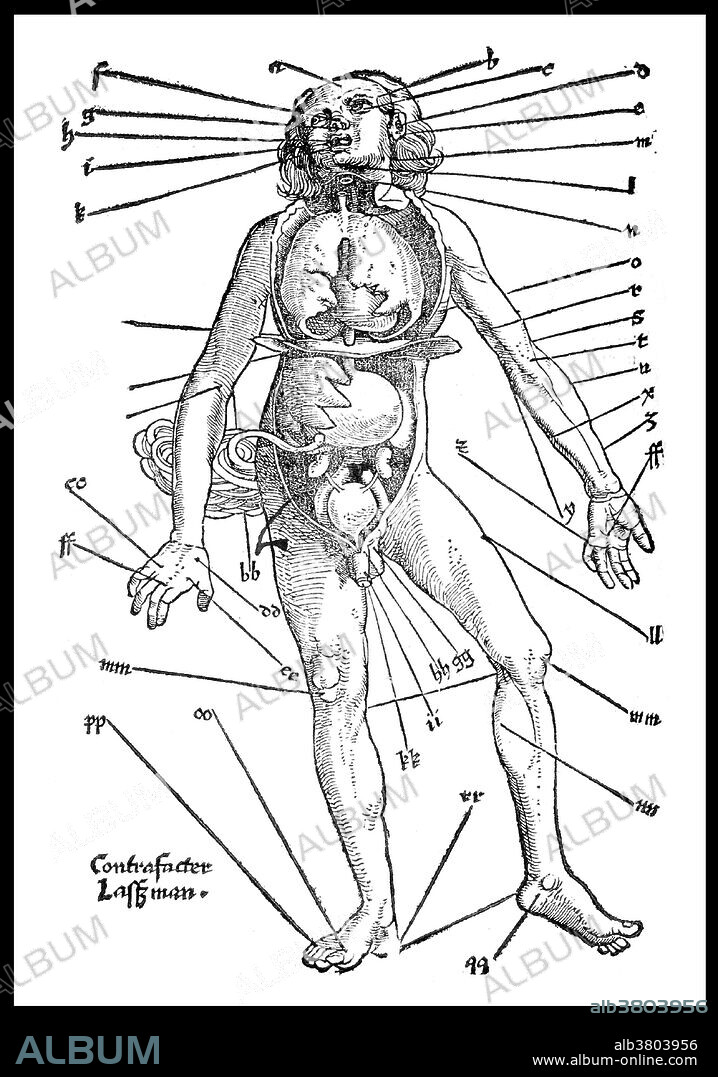alb3803956
Bloodletting, "Feldbuch der Wundartzney", 1528

|
Add to another lightbox |
|
Add to another lightbox |



Title:
Bloodletting, "Feldbuch der Wundartzney", 1528
Caption:
Hans von Gersdorff (1455-1529) was a German surgeon. In 1517, he published Feldbuch der Wundartzney (Fieldbook of Surgery). The book, based on the writings of Guy de Chauliac, served as one of the most basic surgical texts in Europe for a number of years. It was well-known for its advice on limb amputation, of which Gersdorff is reputed to have performed at least 200. The book contains woodcut anatomical images, including a bloodletting figure, "Wound Man," a skeleton, and another figure showing internal organs (the viscera-manikin). Virtually nothing is known about the illustrator, Johann Ulrich Wechtlin. The two folded leaves (the skeleton and the viscera-manikin) were originally published by Johann Schott and were inserted into the book's 1517 edition. In later editions, such as this one printed in 1528, the leaves appear to have been standard illustrations.
Credit:
Album / NLM/Science Source
Releases:
Model: No - Property: No
Rights questions?
Rights questions?
Image size:
3157 x 4500 px | 40.6 MB
Print size:
26.7 x 38.1 cm | 10.5 x 15.0 in (300 dpi)
Keywords:
1520S • 1528 • 16 16TH XVI XVITH SIXTEENTH CENTURY • 16 CENTURY • 16TH CENTURY • 16TH • ANATOMICAL • ANATOMY • ANCIENT SYSTEM • ART • ARTWORK • BLEED (MEDICAL PURPOSE) • BLEEDING • BLEEDING, MEDICINE • BLOOD LETTING • BLOOD-LETTING • BLOODLETTING • BLOODLETTING, MEDICAL • BOOK • BREATHING A VEIN • BW • CELEBRITY • CHART • CURE • DIAGRAM • DRAINING BLOOD • DRAWING • EUROPEA • EUROPEAN • FAMOUS • FELDBCH DER WUNDARTZNEY • FIELDBOOK OF SURGERY • FULL BODY • FULL FIGURE • GERMAN • GERMANS • GERSDORFF • GROSS ANATOMY • HANS VON GERSDORFF • HEMMORHAGE • HEMORRHAGE • HEMORRHAGED • HEMORRHAGING • HISTORIC • HISTORICAL SURGEON • HISTORICAL • HISTORY • HUMAN BODY • HUMAN FIGURE • ILLUSTRATION • IMPORTANT • INFLUENTIAL • MEDICAL • MEDICINAL • MEDICINE • MEDICINE: BLEEDING • NOTABLE • PHLEBOTOMY • POINTS • PREVENT • QUACKERY • SCIENCE • SITES • SURGICAL TEXT • TREATMENT • VON GERSDORFF • WARN • WELL-KNOWN • WESTERN MEDICINE • WHOLE BODY • WHOLE-BODY • WOODBLOCK • WOODCUT • XYLOGRAPHY
 Pinterest
Pinterest Twitter
Twitter Facebook
Facebook Copy link
Copy link Email
Email

